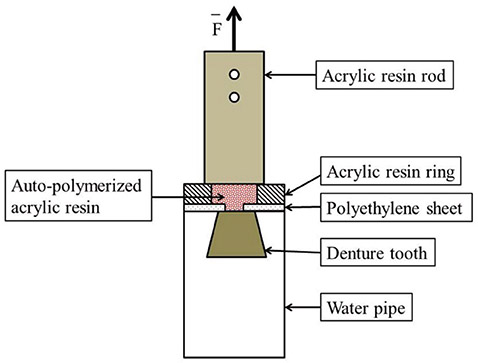J Adv Prosthodont.
2016 Aug;8(4):285-289. 10.4047/jap.2016.8.4.285.
Tensile bond strength between auto-polymerized acrylic resin and acrylic denture teeth treated with MF-MA solution
- Affiliations
-
- 1Department of Prosthodontics, Faculty of Dentistry, Chulalongkorn University, Bangkok, Thailand. chairat.w@chula.ac.th
- 2Developing Research Unit in Polymeric Dental Materials in Prosthodontics, Bangkok, Thailand.
- KMID: 2349336
- DOI: http://doi.org/10.4047/jap.2016.8.4.285
Abstract
- PURPOSE
This study evaluated the effect of chemical surface treatment using methyl formate-methyl acetate (MF-MA) solution on the tensile bond strength between acrylic denture teeth and auto-polymerized acrylic resin.
MATERIALS AND METHODS
Seventy maxillary central incisor acrylic denture teeth for each of three different brands (Yamahachi New Ace; Major Dent; Cosmo HXL) were embedded with incisal edge downwards in auto-polymerized resin in polyethylene pipes and ground with silicone carbide paper on their ridge lap surfaces. The teeth of each brand were divided into seven groups (n=10): no surface treatment (control group), MF-MA solution at a ratio of 25:75 (v/v) for 15 seconds, 30 seconds, 60 seconds, 120 seconds, 180 seconds, and MMA for 180 seconds. Auto-polymerized acrylic resin (Unifast Trad) was applied to the ground surface and polymerized in a pressure cooker. A tensile strength test was performed with a universal testing machine. Statistical analysis of the results was performed using two-way analysis of variance (ANOVA) and post-hoc Dunnett T3 test (α=.05).
RESULTS
The surface treatment groups had significantly higher mean tensile bond strengths compared with the control group (P<.05) when compared within the same brand. Among the surface treatment groups of each brand, there were no significantly different tensile bond strengths between the MF-MA groups and the MMA 180 second group (P>.05), except for the Yamahachi New Ace MF-MA 180-second group (P<.05).
CONCLUSION
15-second MF-MA solution can be an alternative chemical surface treatment for repairing a denture base and rebonding acrylic denture teeth with auto-polymerized acrylic resin, for both conventional and cross-linked teeth.
Keyword
MeSH Terms
Figure
Reference
-
1. Darbar UR, Huggett R, Harrison A. Denture fracture-a survey. Br Dent J. 1994; 176:342–345.2. Cunningham JL. Bond strength of denture teeth to acrylic bases. J Dent. 1993; 21:274–280.3. Takahashi Y, Chai J, Takahashi T, Habu T. Bond strength of denture teeth to denture base resins. Int J Prosthodont. 2000; 13:59–65.4. Meng GK, Chung KH, Fletcher-Stark ML, Zhang H. Effect of surface treatments and cyclic loading on the bond strength of acrylic resin denture teeth with autopolymerized repair acrylic resin. J Prosthet Dent. 2010; 103:245–252.5. Vallittu PK, Lassila VP, Lappalainen R. Wetting the repair surface with methyl methacrylate affects the transverse strength of repaired heat-polymerized resin. J Prosthet Dent. 1994; 72:639–643.6. Asmussen E, Peutzfeldt A. Substitutes for methylene chloride as dental softening agent. Eur J Oral Sci. 2000; 108:335–340.7. Thunyakitpisal N, Thunyakitpisal P, Wiwatwarapan C. The effect of chemical surface treatments on the flexural strength of repaired acrylic denture base resin. J Prosthodont. 2011; 20:195–199.8. Osathananda R, Wiwatwarrapan C. Surface treatment with methyl formate-methyl acetate increased the shear bond strength between reline resins and denture base resin. Gerodontology. 2016; 33:147–154.9. Kungkapilas K, Santawisuk W. Effect of chemical surface treatment on bond strength of a heat-cured acrylic resin denture base and a reline resin. Ciang Mai Dent J. 2014; 35:51–61.10. Penpattanakul S, Wiwatwarrapan C. Effect of chemical surface treatment on microtensile bond strength between acrylic denture teeth and heat-cured acrylic denture base. In : Proceeding The 1st Asean Plus Three Graduate Research Congress; 1-2 Mar. 2012; Chaingmai, Thailand. ST232-7.11. Kawara M, Carter JM, Ogle RE, Johnson RR. Bonding of plastic teeth to denture base resins. J Prosthet Dent. 1991; 66:566–571.12. Suwannaroop P, Chaijareenont P, Koottathape N, Takahashi H, Arksornnukit M. In vitro wear resistance, hardness and elastic modulus of artificial denture teeth. Dent Mater J. 2011; 30:461–468.13. Coffey JP, Goodkind RJ, DeLong R, Douglas WH. In vitro study of the wear characteristics of natural and artificial teeth. J Prosthet Dent. 1985; 54:273–280.14. Clancy JM, Boyer DB. Comparative bond strengths of light-cured, heat-cured, and autopolymerizing denture resins to denture teeth. J Prosthet Dent. 1989; 61:457–462.15. Anderson JN. The strength of the joint between plain and copolymer acrylic teeth and denture base resins. Br Dent J. 1958; 104:317–312.16. Darbar UR, Huggett R, Harrison A, Williams K. The tooth-denture base bond: stress analysis using the finite element method. Eur J Prosthodont Restor Dent. 1993; 1:117–120.17. Vallittu PK, Ruyter IE, Nat R. The swelling phenomenon of acrylic resin polymer teeth at the interface with denture base polymers. J Prosthet Dent. 1997; 78:194–199.18. Hopfenberg HB, Stannett V. The diffusion and sorption of gases and vapours in glassy polymers. In : Haward RD, editor. The Physics of glassy polymers. London: Applied Science Publishers;1973. p. 504–547.19. Grulke EA. Solubility parameter values. In : Brandrup J, Immergut EH, Grulke EA, editors. Polymer Handbook. 4th ed. New York: Wiley;1999. p. 696–697. p. 70820. Civjan S, Huget EF, de Simon LB. Modifications of the fluid resin technique. J Am Dent Assoc. 1972; 85:109–112.21. Suzuki S, Sakoh M, Shiba A. Adhesive bonding of denture base resins to plastic denture teeth. J Biomed Mater Res. 1990; 24:1091–1103.22. Hao Z, Yin H, Wang L, Meng Y. Wear behavior of seven artificial resin teeth assessed with three-dimensional measurements. J Prosthet Dent. 2014; 112:1507–1512.
- Full Text Links
- Actions
-
Cited
- CITED
-
- Close
- Share
- Similar articles
-
- Tensile bond strength of four denture resins to porcelain teeth with different surface treatment
- THE SHEAR BOND STRENGTH OF RESIN TEETH TO THE DENTURE BASE RESIN
- Effect of surface treatment methods on the shear bond strength of auto-polymerized resin to thermoplastic denture base polymer
- Comparison of shear bond strengths of different types of denture teeth to different denture base resins
- Effect of denture base surface pretreatments on the tensile bond strength between a resilient liner and a processed denture base resin


